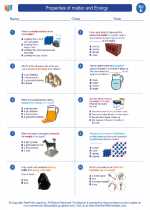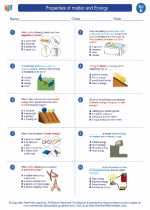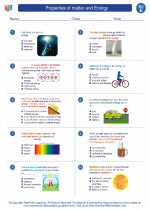Properties of matter and Energy -> conductor
Conductor
A conductor is a material that allows the flow of electric current. In other words, it conducts electricity. Conductors are an essential part of electrical circuits, as they provide a path for the flow of electrons. This allows electrical devices and systems to function properly.
Characteristics of Conductors
Conductors have several key characteristics:
- Electrical conductivity: Conductors have high electrical conductivity, meaning they allow electric current to flow through them easily.
- Free electrons: At the atomic level, conductors have free electrons that are able to move easily within the material when a voltage is applied.
- Malleability and ductility: Many conductors, such as metals, are malleable and ductile, which means they can be easily shaped and stretched into wires or other forms.
- Low resistance: Conductors have low resistance to the flow of electric current, which minimizes energy loss and heat generation.
Examples of Conductors
Common examples of conductors include:
- Copper: Copper is one of the most widely used conductors due to its high conductivity and abundance.
- Aluminum: Aluminum is another common conductor used in electrical wiring and transmission lines.
- Silver: Silver has the highest electrical conductivity of any metal and is used in specialized applications.
- Gold: Gold is a highly conductive metal often used in electronics and telecommunications.
- Iron: Iron and other metals also exhibit conductive properties, though they may have higher resistance compared to copper and aluminum.
Study Guide
To understand conductors better, consider the following study guide questions:
- What is the role of conductors in electrical circuits?
- How does the atomic structure of conductors contribute to their ability to conduct electricity?
- Compare and contrast the conductivity of copper, aluminum, and silver.
- Explain why metals are often used as conductors in electrical applications.
- Discuss the significance of low resistance in conductors.
By studying these questions and exploring the characteristics and examples of conductors, you can gain a comprehensive understanding of this important concept in electrical engineering and science.
.◂Science Worksheets and Study Guides Fifth Grade. Properties of matter and Energy
Study Guide Properties of matter and Energy
Properties of matter and Energy  Worksheet/Answer key
Worksheet/Answer key Properties of matter and Energy
Properties of matter and Energy  Worksheet/Answer key
Worksheet/Answer key Properties of matter and Energy
Properties of matter and Energy  Worksheet/Answer key
Worksheet/Answer key Properties of matter and Energy
Properties of matter and Energy  Vocabulary/Answer key
Vocabulary/Answer key Properties of matter and Energy
Properties of matter and Energy  Vocabulary/Answer key
Vocabulary/Answer key Properties of matter and Energy
Properties of matter and Energy 

 Worksheet/Answer key
Worksheet/Answer key
 Worksheet/Answer key
Worksheet/Answer key
 Worksheet/Answer key
Worksheet/Answer key
 Vocabulary/Answer key
Vocabulary/Answer key
 Vocabulary/Answer key
Vocabulary/Answer key

The resources above cover the following skills:
PHYSICAL SCIENCE (NGSS)
Matter and Its Interactions
Students who demonstrate understanding can:
Develop a model to describe that matter is made of particles too small to be seen.